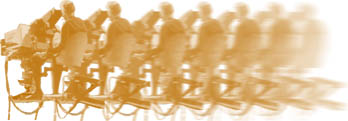

|
You may well have an inkling that there are a few mad individuals who collect and maintain - just for
the fun of it - heavyweight 'antique' tv studio apparatus consisting of gigantic tubed monochrome
cameras with turrets full of cannon-sized lenses, enormous lunky half-ton pedestals and miles of
cable as thick as an elephant's water sucker. Pachyderms aside, I have to confess that I too am one of those fun-loving tv maniacs. I own a couple of dozen (yes dozen) television cameras, plus dollies, pedestals, lights and monitors, all collected with meticulous and muscle-building care. This vast store of elderly telly equipment resides happily in my specially built ‘studio’. If this sounds totally potty it’s because I consider the preservation of old black and white television cameras quite important. Naturally, there's an industrial/historical perspective, plus museum interest. However, what little 'historic' tv equipment now remains can perhaps, remind us, technologically, of where we came from, (and remember it was all British kit in those days!) Another bonus is that increasing use is being made of this old tv technology as props in tv drama, film and pop music promotion. Some of my vintage camera collection has been seen in old monochrome 're-creations', 1960s dramatic flashbacks and a few forgettable music combo ditties. It's indeed fortunate that anything at all survives from the olden telly days. Normally, television equipment is junked after use and that's an end to it. Today, the 'golden age' of monochrome television is almost totally lost and some types of camera have vanished forever. For example a lot of pioneering Pye iconoscope and EMI Emitron tv cameras are extinct. Each of my tv cameras (including movie cameras) has been sympathetically restored. I do, however, follow a few golden rules. The 'trade secrets' I'm about to reveal are all of my own devising. They've worked well for me but are no guarantee of success. For starters, when I attempt to restore a camera (and this goes for any other electronic antique), the very worst procedure is to apply lavish coats of fresh paint whilst stuffing the innards with a complete change of components. The end result might look attractive, but it's only a hybrid modern 'too new' object pretending to be an original. Attempting to 'revive' old television cameras poses a host of problems. The easiest course is to bring the equipment back to something approaching a typical (and perhaps fanciful) 'mid-life working' appearance. This is ideal for recreating an era, providing the camera is has proper livery and is correctly badged. Cosmetic restoration is a short-term solution. Complex internal electronic revivals are best left to knowledgeable tekkies with time on their hands. However, this needs to be undertaken at some stage. Exhibitions sometimes demand working exhibits! When I found my broadcast cameras, they were (with a few exceptions) discovered in damp store rooms, garage floors or the proverbial skip. These cameras were at the end of their working lives and looked it, but with a modicum of effort, all the cameras were cleaned and spruced effectively back to 'operational' condition. For example, a 1957 Marconi Mk III 4½" image orthicon camera was discovered in 1996 languishing in a creeper-infested garden shed in Southport. The poor old camera was growing it's own spinach as well as playing host to a colony of arachnids. But fortunately the camera was not rusty and there was only a superficial corrosion, easily dealt with. The big circular lens turret had seized solid, but an overnight soak in WD4O loosened the essentials and the mechanism eventually swung free. Although the camera had lain idle and neglected for 15 years, (it had worked on the original 1964 BBC series of 'Top of the Pops'), internally the camera appeared in almost working order. Of course, there will be many components to replace before this particular Marconi Mk III ever again produces a picture in anger! More pictures and info about Dicky Howett’s collection can be seen at www.golden-agetv.co.uk |
 |